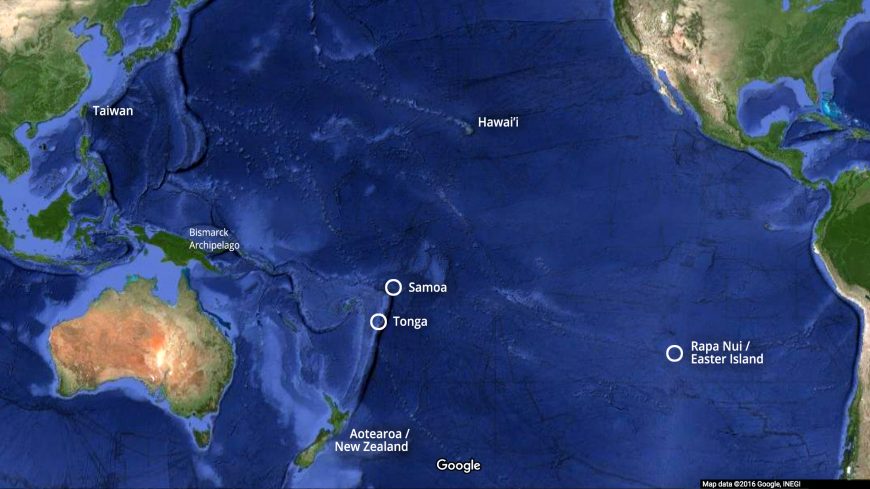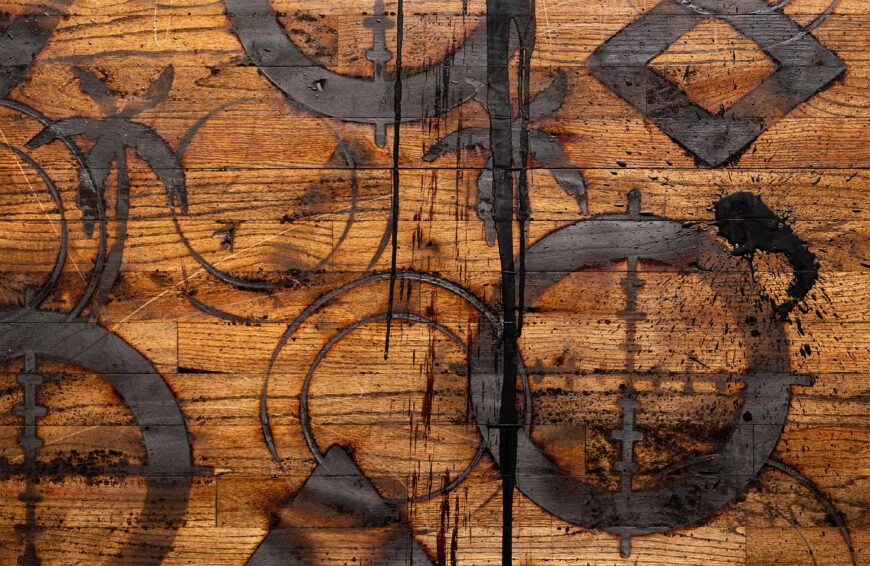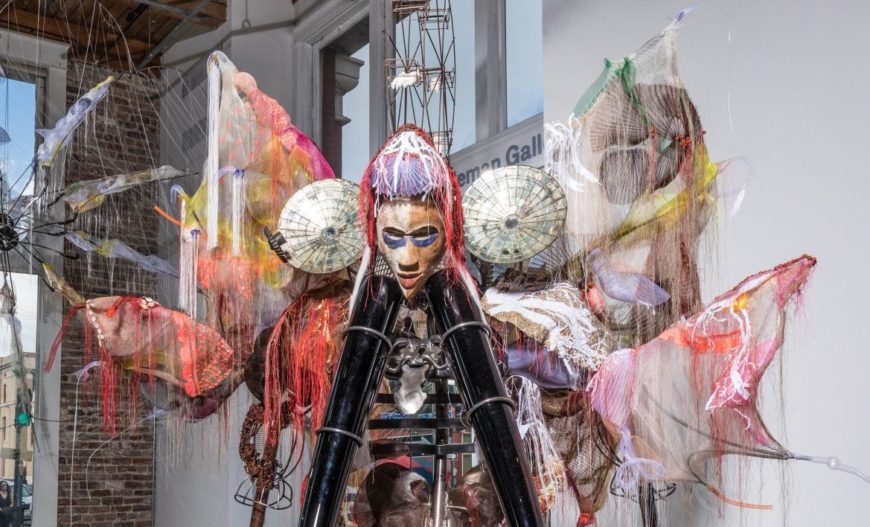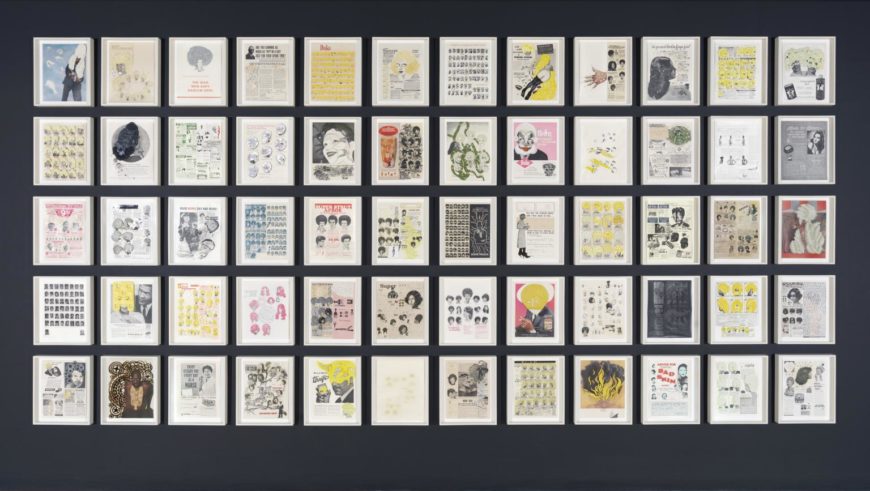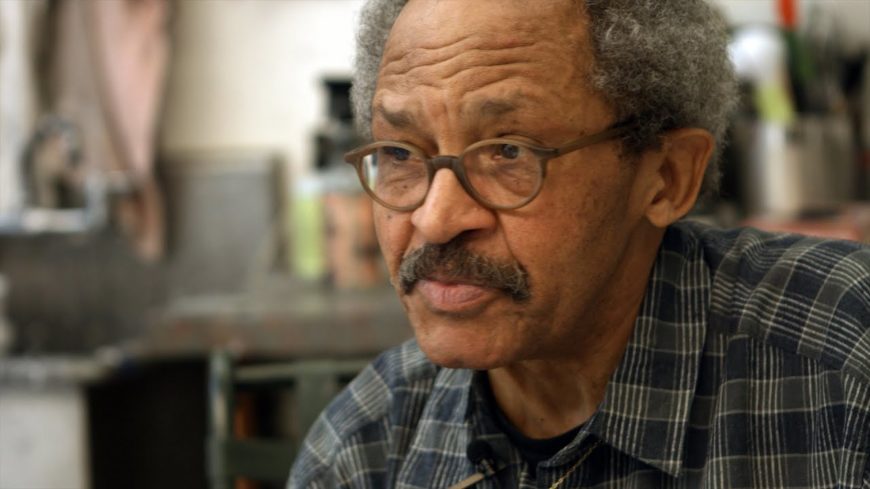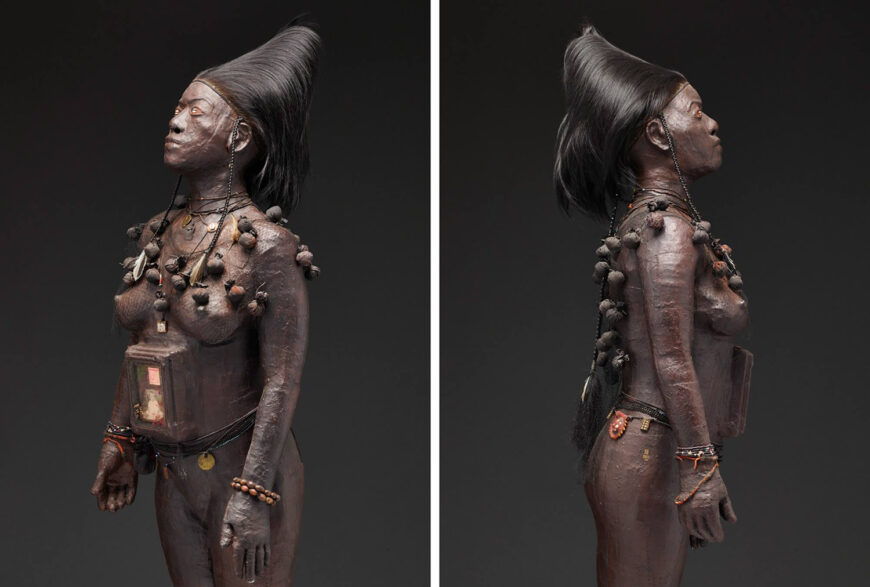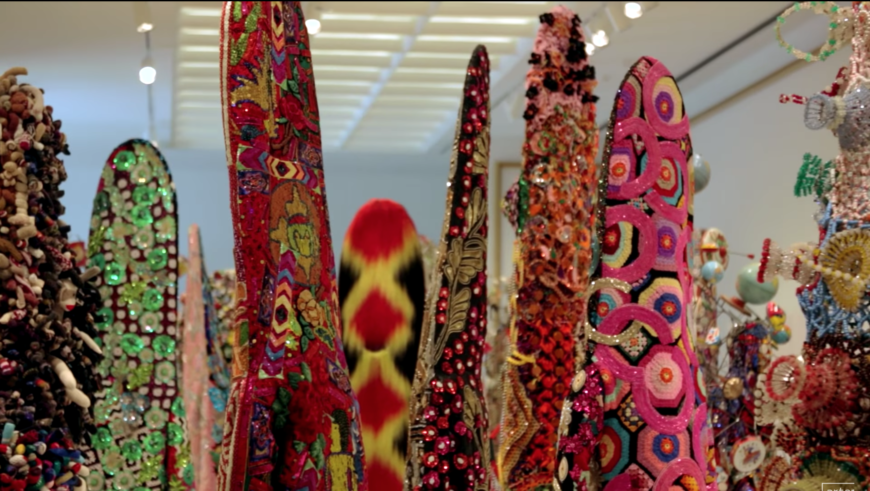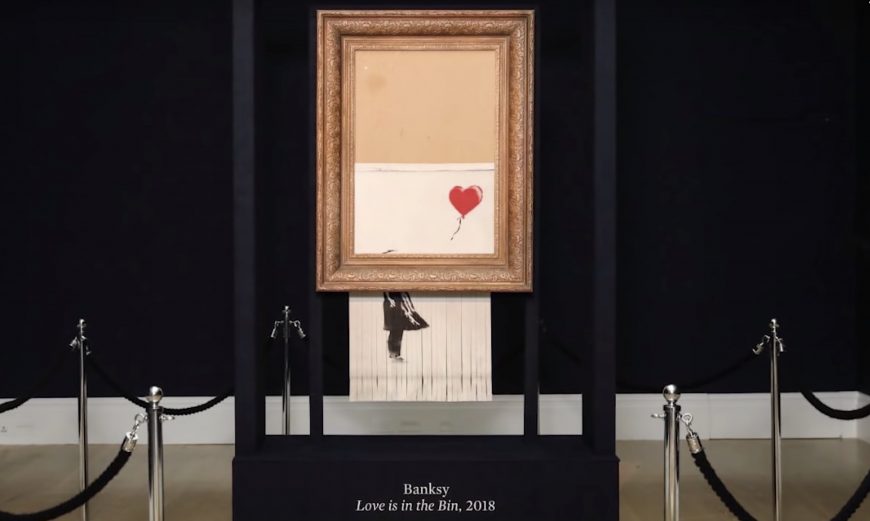Fatu Feuʻu’s four decade-long career encompasses the emergence of the burgeoning Pacific art scene in Aotearoa New Zealand from the 1980s to the 2020s (and he continues to regularly exhibit). He is regarded as one of the first Pacific artists to establish himself professionally in Aotearoa and has been described as the Father of Contemporary Pacific Art. His paintings, sculptures, prints, and ceramics draw on a range of customary Samoan art forms including siapo (decorated barkcloth), tatau (tattoo), and carving. They are also redolent with metaphors of navigation and journeying, reflecting his own migration from his homeland of Sāmoa to Aotearoa New Zealand in 1966.
The 1950s and 1960s saw large numbers of Pacific people migrating to Aotearoa. Like many of them, Feuʻu started out working in factories until settling in Auckland, home to the largest Pacific community, in the mid 1970s. There, he gradually established himself within the local artists community. His earliest works were primarily in the mediums of painting and lithography, however he soon developed broader interests which ranged across a wide and diverse number of media including painting, glasswork, carpet, ceramics, installation and monumental sculpture, poetry, and printmaking.
From the late 1980s, Feuʻu also played an active role in supporting his fellow artists, as well as mentoring younger New Zealand-born Pacific artists. He regularly included them in his exhibitions and organized group shows that contributed to the development of a platform from which a generation of artists would emerge to dominate the New Zealand art scene across the 1990s. Feuʻu also founded the Tautai Contemporary Pacific Arts Trust in the mid-1990s, a collective that continues to support Pacific artists.

Fatu Feuʻu, Faʻaola Mo Taeao Conserve for Tomorrow, 1990, oil on canvas, wood, barkcloth, pigment, and ceramic (Feuʻu Marsh Trust collection) © Fatu Feuʻu
Referencing Faʻa Sāmoa (the Samoan way)
Faʻaola Mo Taeao Conserve for Tomorrow is a mixed media work produced in the early 1990s. It comprises three paintings and four wooden sculptural forms, and epitomizes Feuʻu’s signature painting style across this decade. The paintings feature the artist’s highly recognizable bright colors and grid composition that echo the structure of Samoan siapo (barkcloth) design, along with his stylized flower, mask, and frigate bird motifs. This visual aesthetic would come to signify “Pasifika” for many, in a decade that saw the establishment of the first Pasifika festivals, fashion, and design in Aotearoa. These events celebrated Pacific Islander cultures and artforms with a particular focus on the innovations and expressions of migrant communities based in Aotearoa New Zealand.
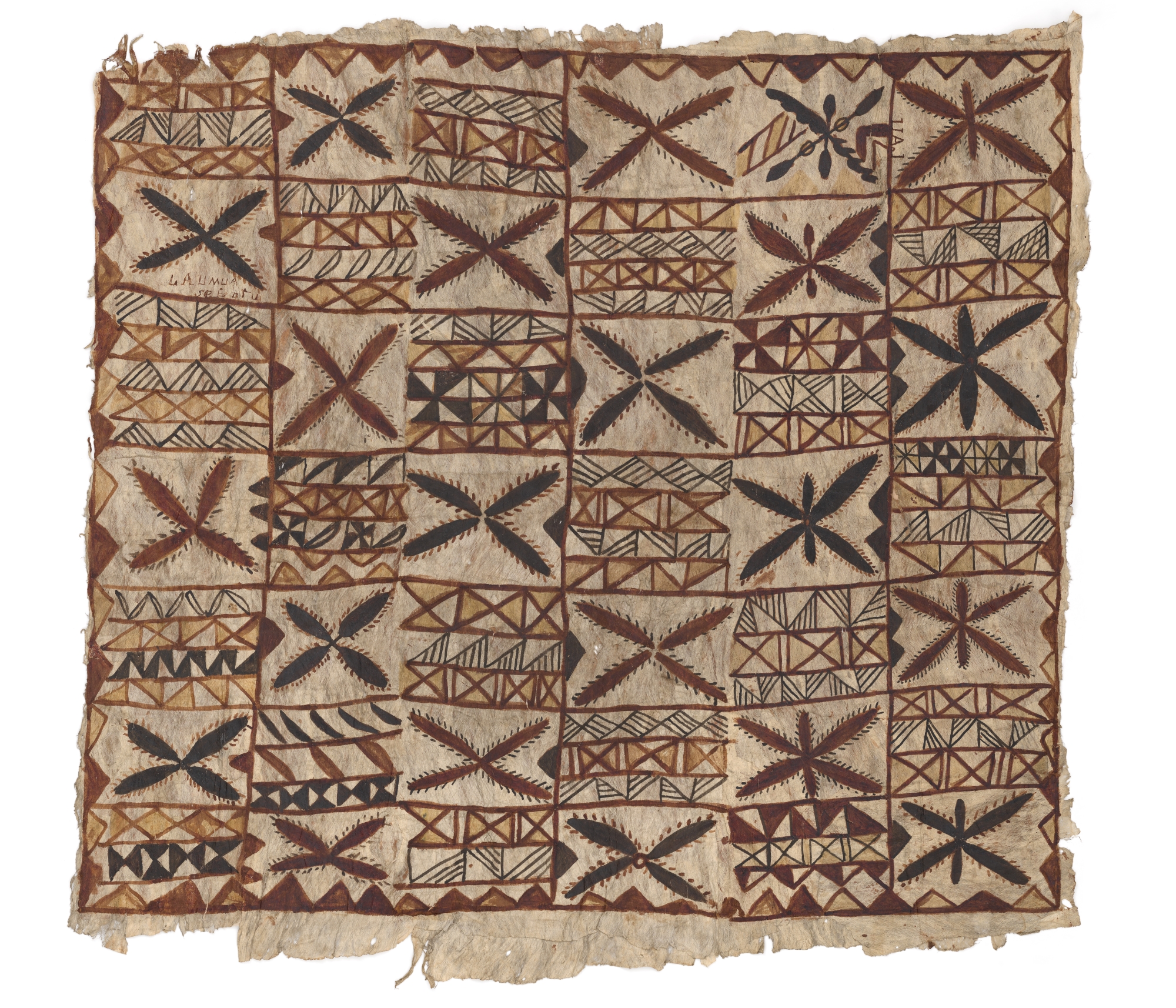
Unidentified artist, Siapo mamanu, 1890s (Sāmoa), tapa (bark) cloth, 142 x 136 cm (Museum of New Zealand Te Papa Tongarewa, Wellington)
Feuʻu’s Conserve for Tomorrow also features mixed media elements. Juxtaposed within and around the three canvases are wooden sculptures that draw on outrigger canoe forms and digging sticks used for tending gardens. These references celebrate centuries-old practices of navigation and sustainable practices of working the land. They were inspired by the artist’s childhood memories growing up in the village of Poutasi, Sāmoa, where he would watch his mother, grandmother, and aunties making and designing barkcloth. Feuʻu drew on and developed these stylized patterns and designs to create a series of works, which would often reference aspects of the Faʻa Sāmoa (the Samoan way) such as faʻaaloalo (respect and reverence), alofa (love and compassion), and tautua (service and obligation).
Conserve for Tomorrow also reflects Feuʻu’s ongoing concern for the environment and the need to protect it for future generations. While the overall visual aesthetic of the work reflects an affirming array of familiar Polynesian patterns and motifs, they are also encoded with references highlighting the importance of caring and preserving the environment—its plants and animals, along with its ancient histories and customs that are intimately connected to the natural world and ancestral genealogies. These concerns are addressed in a number of his paintings, which highlight issues like the dangers of driftnet fishing, among other unsustainable practices.
It is important to understand that in the early 1980s, when Feuʻu was developing his art practice, there was no community of Pacific artists regularly exhibiting in Aotearoa New Zealand, and the now familiar Pasifika style and aesthetic did not exist. In contrast to the prevailing politicized protest art that dominated much of the work of Māori artists at that time, Feuʻu was struck by the lack of other Polynesian cultural references, and felt strongly that he needed to represent something of his own Samoan culture. [1] His experience and development as an artist who was born and raised in Sāmoa was different than the majority of Pacific Islander artists who were born in New Zealand. While many of them explore and critique issues of identity, tradition, and the migration experience by developing a counter-practice—what has been termed representation or identity politics—Feuʻu chose not to do this. In contrast to Jim Vivieaere’s (a New Zealand artist of Cook Islands Māori descent) often quoted reference to the plight of Pacific artists as being in a “three-legged race,” Feuʻu instead chose to see the diasporic experience differently, stating, “I wanted to stand firm, as a Samoan here in New Zealand and [represent] who I am.” [2]

Fatu Feuʻu, Faʻaola Mo Taeao Conserve for Tomorrow, 1990, oil on canvas, wood, barkcloth, pigment, and ceramic (Feuʻu Marsh Trust collection) © Fatu Feuʻu
Another key thematic that can be seen across Feuʻu’s vast body of work highlights important connections between generations and the role that grandparents and parents can play in supporting their families and transmitting cultural knowledge and values. Alongside the bright yellow flower forms in Conserve for Tomorrow, which have been described as frangipani, are stylized mask motifs that allude to pre-colonial religious practices. Frigate bird forms also feature in the composition to the lower left, and mid-right sides of the panels, signaling ancestral presences and highlighting the important relationships between the long-distance flying birds and navigators who would track their flight paths.
The carved sculptural forms to the far left and right of the painted panels create a visual metaphor of travel through their references to canoe outriggers. These types of canoes are traced back to the early Lapita voyagers and settlers of the Pacific Ocean (beginning as early as 1600 B.C.E.) and into the present, as Feuʻu also evokes present-day migration of Pacific people to Aotearoa New Zealand and around the world. The continuum of voyaging and travel across time—from the ancient Polynesian settlers guided by their master navigators, known in Sāmoa as tautai, into the present—is an ongoing reference in Feuʻu’s work.
The siapo cloth that is wrapped around the central area of the sculptures reflects the importance of the textiles, made by women, in relation to customary exchanges and gifting. This practice highlights the rank and mana of those who adorn themselves with the cloth, as well as foregrounds intimate connections between Pacific people and the environment, as the textiles are made from the inner bark or skin of the uʻa (paper mulberry tree). It also evokes the practice of wrapping textiles around people and objects on important occasions.
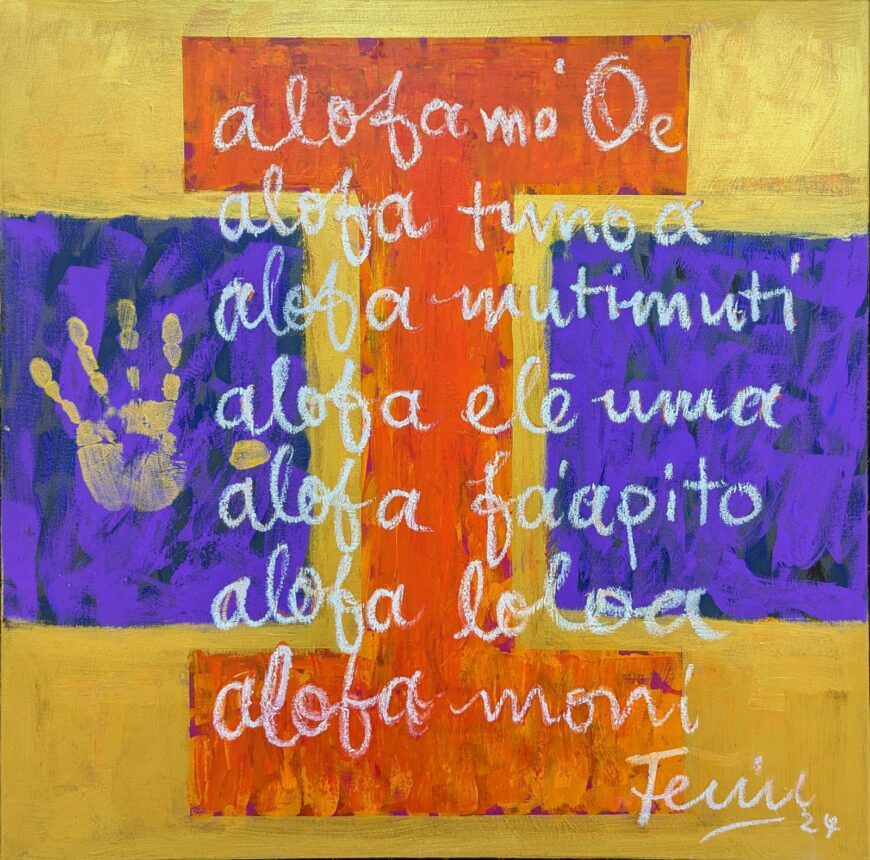
Fatu Feuʻu, Alofa Tūnoa (Ancient Love), 2024, acrylic and oil stick on canvas, 29.5 x 29.5 inches (Courtesy of Bergman Gallery) © Fatu Feuʻu
Sustainable futures
In the mid-1990s, Feuʻu’s painting practice changed. As his reputation grew locally and internationally, he took on more responsibilities within his family and community. Feuʻu holds three chiefly titles: the Tulafale Orator title of Siʻa from Poutasi; Lesa, a sacred aliʻi (chiefly) title; and Papaaliʻi, from his mother’s family. Perhaps as a reflection of his complex understanding of cultural obligations and practices, his palette became darker and he began to incorporate text, including Samoan sayings and concepts, poetry, biblical passages, and songs from the Mau movement for Samoan independence. New motifs were also incorporated, including the paddle, handprint, and “kissing fishes.” Into the 2000s, his distinctive grid gave way to a now familiar “I” form which has become a central motif around which the artist structures his compositions. This form references the first letter of the Samoan ritual of ifoga, a collective expression of asking for forgiveness and seeking reconciliation.
Conserve for Tomorrow remains an important work within Feuʻu’s oeuvre as it not only signals the development of his early practice emerging from the 1980s, but also reflects key concerns that he continues to explore and develop over time. Respect, love, responsibility, and service are all key aspects of the Faʻa Sāmoa that continue to offer Indigenous responses to and solutions for sustainable relationships and futures.


